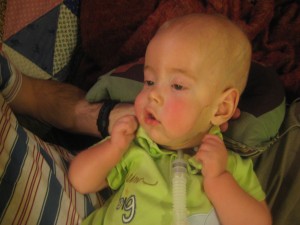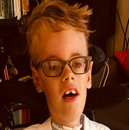Appointments and learning (April 7)
On the way back from Children’s on Monday we made it a leisurely trip, stopping off at our favorite vegan lunch spot to pick up food before bringing a sleeping Lucas back to our apartment. It was our third trip to Children’s in five business days, a rather remarkable feat in itself, but noteworthy especially for how routine its become to transport Lucas to such appointments. He’s gotten used to it and so have we. Which isn’t to say that we love making such frequent trips to the hospital (in fact we don’t have another appointment for a week and a half – phew!) but just that like many things with Lucas that would have seemed unimaginable a year ago, regular visits with doctors and therapists is now just a normal part of our reality.
So what did we learn in those appointments? The visit last Tuesday with the neuromuscular doctor who diagnosed Lucas was the most highly anticipated, but didn’t end up being as informative as we had expected. Perhaps it was because we’ve already learned so much about Myotubular Myopathy, but despite sitting with him for over an hour, Dr. Leshner didn’t really have much new to offer. He said that Lucas’s particular genetic mutation doesn’t really tell us anything about his prognosis; as a muscle disease, x-linked MTM is severe in all cases, but every child still develops differently within a spectrum. Though he seemed moderately impressed with Lucas’s progress so far he refused to offer many predictions on where he would be a few years from now. He seemed somewhat concerned about the large size of the ventricles in Lucas’s brain and said that his big, funny-shaped head was not related to MTM but rather to the bleeding in his brain at birth (this contradicted some of what we had learned from than the neurosurgeon and the other neurologist that knows Lucas).
In terms of possible treatments for Lucas, he seemed intent on offering little hope. We asked him about mice studies that have shown possibilities for a treatment related to Calcium but he was unimpressed (thanks to Sara for finding the MTM research and sharing the articles with us). He allowed that some years from now doctors and researchers will know more and that there may be some progress on treatments for muscle diseases like MTM, but that was about all we got out of him.
We came away from the appointment disappointed but not disheartened. Other doctors, not to mention our own connections and research, will continue to lead us towards new discoveries and possibilities with Lucas, while his therapies will continue to help him progress.
 On the other hand, we were pleasantly surprised by an appointment a few days later with the child development specialist. We had heard reports that this particular doctor had tough standards and tended to be rather negative. Instead, she and her assistant encouraged us to be even more optimistic about Lucas’s condition and possibilities. They were impressed by Lucas’s deliberate grabbing at toys and also glad to hear that he has been developing a bigger range of facial expressions. They told us that we should assume that those expressions have been “inside” Lucas for a while now — what’s new is the way that Lucas is working his facial muscles, not the cognitive or emotional experience that leads to the smile itself. This brought us back to a comment by the neuromuscular doctor related to a major challenge that Lucas will face: even as he grows and his mind develops and processes the outside world in ways similar to his peers, people will tend to underestimate him. Why? Because his limited movement and especially the low muscle tone in his face will give an impression that he’s not following or cognitively understanding.
On the other hand, we were pleasantly surprised by an appointment a few days later with the child development specialist. We had heard reports that this particular doctor had tough standards and tended to be rather negative. Instead, she and her assistant encouraged us to be even more optimistic about Lucas’s condition and possibilities. They were impressed by Lucas’s deliberate grabbing at toys and also glad to hear that he has been developing a bigger range of facial expressions. They told us that we should assume that those expressions have been “inside” Lucas for a while now — what’s new is the way that Lucas is working his facial muscles, not the cognitive or emotional experience that leads to the smile itself. This brought us back to a comment by the neuromuscular doctor related to a major challenge that Lucas will face: even as he grows and his mind develops and processes the outside world in ways similar to his peers, people will tend to underestimate him. Why? Because his limited movement and especially the low muscle tone in his face will give an impression that he’s not following or cognitively understanding.
The developmental specialists had a number of good suggestions about how to interact with and talk to Lucas but also warned about over-stimulation. She said that when Lucas makes uncomfortable faces, or rubs his eyes, or stretches out his body and looks at the blank wall behind him, it’s possible that he’s communicating that he’s done playing. He certainly has lots of toys and bright colored objects hanging from and around his crib, and plenty of the two of us making goofy faces in front of him… maybe sometimes he just gets sick of it all! One other noteworthy thing is that they believe Lucas is likely hearing us despite the test in February that showed some moderate hearing loss, and encouraged us to continue speaking to him with a well-projected voice.
Perhaps we came away feeling good about the 2-hour appointment in large part because they didn’t say anything overtly negative, and didn’t do anything to quell our own enthusiasm about Lucas’s progress. On a similar note, the third trip to the hospital of the week – a session with the occupational therapist – produced positive results. Lucas bounced around on a giant red rubber ball, practicing rolling over and reaching out to brace himself. A few times Krista almost had a heart attack seeing the way that Cathy tossed Lucas around, but we trust her and were excited to realize that we don’t need to be ultra-delicate with Lucas at all times.


Comments (4)
Ann Schrooten
April 8th, 2010 at 11:13 pm
You guys are awesome, advocating parents and Lucas is very lucky to have you! You have the right attitude in taking what the professionals say with a grain of salt. Lucas and time will tell you everything you need to know.
Ann
Mary G
April 8th, 2010 at 1:10 pm
Ditto on genes not determining everything. Rannie and his identical twin are *very* different from one another. Thanks for the continuing updates, pics and videos. I tend to check most every day, even though I don’t post much or contact you much. Hope to see you all again soon, though. Hugs, hugs!
jocelyn
April 8th, 2010 at 8:56 am
Someone needs to tell Dr. Leshner that it’s possible to be realistic and positive at the same time. He’s probably grumpy and negative about everything in life, not just MTM.
I just heard a fascinating story on NPR where a bunch of geneticists were talking about how genes do not determine everything. For example, only 80% of people who have the baldness gene actually go bald, and identical twins often develop differently, etc. The point to the story was that genes of course matter, but that how they matter is influened by their environment–physical, social, chemical–far more than most doctors care to admit, and far more than any of them understand.
Ok, sorry for the marathon comment. I just hate that anyone on Lucas’ team might underestimate him, especially given how far he’s come already. Anyway…I’ve got a great route to information figured out for you if you’re still interested, just too much to put into email, so give me a call any time it works for you!
Sending love and hugs!
Sara
April 7th, 2010 at 10:41 pm
I’m sorry to hear that the appointment with Dr. Leshner didn’t go as well as you had hoped. It sounds like he is trying not to get your hopes up since at this point a calcium-centered therapy has not even been looked at in animal models, so it is still a ways off. None-the-less it is a lead and I will keep my eyes out for more articles. Let me know if you need help getting access to any articles you come across as well. Thanks for posting the recent videos and photos of Lucas, I love seeing how he is growing and improving!
Leave a reply